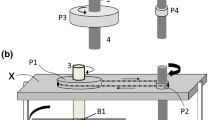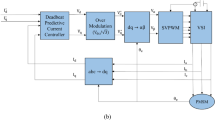Abstract
With the adoption of 3D magnetic flux material and global ring windings, permanent magnet transverse flux machine (PMTFM) with soft magnetic composite cores can output relatively high torque density and only requires easy manufacturing process. For the PMTFM, there are two ways to put the permanent magnets (PMs). One is to put the PMs on the rotor side which is the traditional rotor PM TFM and the other is to put the PMs on the stator side which is the stator PM TFM. In this paper, the design methods and operation principle for both kinds of PMTFM will be presented and discussed. Four different TFMs (benchmark rotor PM TFM with NdFeB, stator PM TFM1 with ferrite magnet and stator PM TFM2 and TFM3 with NdFeB) have been designed, and the magnetic parameters and the main performance will be comparatively studied to show the main difference between stator PM TFM and rotor PM TFM. It can be seen that the stator PM TFM has better performance, and the stator PM TFM1 with ferrite magnets can have the same torque ability as that of the rotor PM TFM with NdFeB magnet but with very low material cost. With the adoption of NdFeB, the stator PM TFM2 can have two times higher torque ability than the rotor PM TFM, and the stator PM TFM2 can have the same torque ability as that of rotor PM TFM but with much smaller volume. As for the power factor and efficiency, it can be seen that the adoption of ferrite magnet will reduce both of them, and there is no much difference for the place where the PMs are installed.
















Similar content being viewed by others
References
Krings A, Boglietti A, Cavagnino A, Sprague S (2017) Soft magnetic material status and trends in electric machines. IEEE Trans Ind Electron 64(3):2405–2414
Schoppa A, Delarbre P (2014) Soft magnetic powder composites and potential applications in modern electric machines and devices. IEEE Trans Magn 50(4):2004304
Potgieter J, Fernandez F, Fraser A, Mcculloch M (2017) Effects observed in the characterization of soft magnetic composite for high frequency, high flux density applications. IEEE Trans Ind Electron 64(3):2486–2493
Zhu JG, Guo YG, Lin ZW, Li YJ, Huang YK (2011) Development of PM transverse flux motors with soft magnetic composite cores. IEEE Trans Magn 47(10):4376–4383
Jack AG (2000) Permanent magnet machines with powdered iron cores and prepressed windings. IEEE Trans Ind Appl 48(11):1077–1084
Guo YG, Zhu JG, Watterson PA, Wu W (2006) Development of a PM transverse flux motor with soft magnetic composite core. IEEE Trans Energy Convers 21(2):426–434
Liu CC, Lei G, Wang TS, Guo YG, Wang YH, Zhu JG (2017) Comparative study of small electrical machines with soft magnetic composite cores. IEEE Trans Ind Electron 64(2):1049–1060
Zhang B, Seidler T, Dierken R, Doppelbauer M (2016) Development of a yokeless and segmented armature axial flux machine. IEEE Trans Ind Electron 63(4):2062–2071
Doering J, Steinborn G, Hodman W (2015) Torque, power, losses, and heat calculation of a transverse flux reluctance machine with soft magnetic composite materials and disk shaped rotor. IEEE Trans Ind Appl 51(2):1494–1504
Washington J, Atkinson J et al (2012) Three phase modulated pole machine topologies utilizing mutual flux paths. IEEE Trans Energy Convers 27(2):507–515
Kwon YS, Kim WJ (2017) Electromagnetic analysis and steady-state performance of double sided flat linear motor using soft magnetic composite. IEEE Trans Ind Electron 64(3):2178–2187
Ishikawa T, Takahashi K, Viet HQ, Matsunami M, Kurita N (2012) Analysis of novel brushless DC motors made of soft magnetic composite core. IEEE Trans Magn 48(11):971–974
Anglada JR, Sharkh SM (2015) An insight into torque production and power factor in transverse flux machines. IEEE Trans Ind Appl 53(3):1971–1977
Husain T, Hasan I, Sozer Y, Husain I, Uuljadi E (2018) Design considerations of a transvers flux machine for direct dirve wind turbine applications. IEEE Trans Ind Appl 54(4):3604–3615
Ahmed A, Husain I (2018) Power factor improment of a transverse flux machine with high torque density. IEEE Trans Ind Appl 54(5):4297–4305
Guo YG, Zhu JG, Dorrell DG (2009) Design and analysis of a claw pole permanent magnet motor with molded soft magnetic composite core. IEEE Trans Magn 45(10):4582–4585
Li X, Xu W, Ye CY, Boldea I (2018) Comparative study of transverse flux permanent magnetic linear oscillatory machines for compressor. IEEE Trans Ind Electron 65(9):437–7446
Wang MQ, Zheng P, Tong CD, Zhao QB, Qiao GY (2019) Research on a transverse flux brushelss double rotor machine for hybrid electric vehicles. IEEE Trans Ind Electron 66(2):1032–1043
Zhao M, Wei Y, Wang HY, Hu MM, Han FJ et al (2019) Development and analysis of novel flux switching transverse flux permanent magnet linear machine. IEEE Trans Ind Electron 66(6):4923–4933
Zhao X, Niu SX (2019) Development of a novel transverse flux tubular linear machine with parallel and complementary PM magnetic circuit for precision industrial processing. IEEE Trans Ind Electron 66(6):4945–4955
Husain T, Hasan I, Sozer Y, Husain I, Uuljadi E (2019) Cogging torque minzation in transverse flux machines. IEEE Trans Ind Appl 55(1):385–397
Ma B, Lei G, Zhu JG, Guo YG, Liu CC (2018) Application-oriented robust design optimization for batch production of permanent magnet motors. IEEE Trans Ind Electron 65(2):1728–1739
Lei G, Wang TS, Guo YG, Zhu JG, Wang SH (2014) System level design optimization methods for electrical drive systems: deterministic approach. IEEE Trans Ind Electron 61(12):6591–6602
Liu CC, Zhu JG, Wang YH et al (2017) Development of a new low cost 3-D flux transverse flux FSPMM with soft magnetic composite cores and ferrite magnets. IEEE Trans Magn 53(11):8109805
Funding
This material is based upon work supported by Natural Science Foundation of Hebei Province under Grant No. E2019202220 and National Natural Science Foundation of China under Grant No. 52007047.
Author information
Authors and Affiliations
Corresponding author
Additional information
Publisher's Note
Springer Nature remains neutral with regard to jurisdictional claims in published maps and institutional affiliations.
Rights and permissions
About this article
Cite this article
Liu, C., Wang, X., Wang, Y. et al. Comparative study of rotor PM transverse flux machine and stator PM transverse flux machine with SMC cores. Electr Eng 104, 1153–1161 (2022). https://doi.org/10.1007/s00202-021-01363-w
Received:
Accepted:
Published:
Issue Date:
DOI: https://doi.org/10.1007/s00202-021-01363-w




